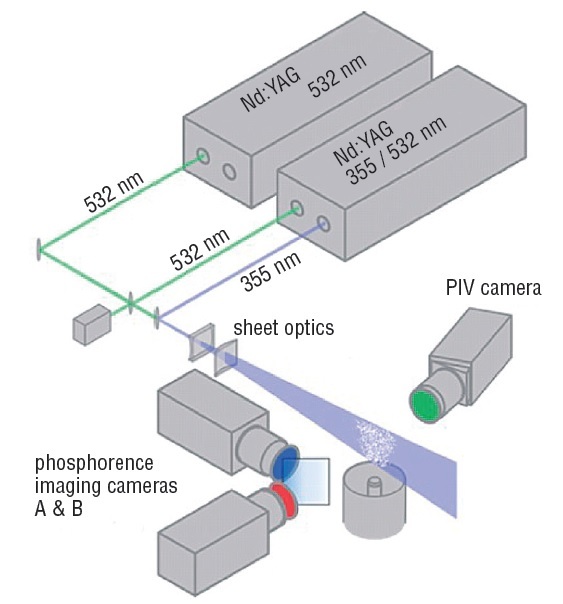方案详情
文
采用LaVision公司的FlowMaster系统测量平面流动的速度场分布,同时用红外相机测量温度场。这对研究热传导机制非常有效。
方案详情

Proceedings ofthe 3nd International Conference on Fluid Flow, Heat and Mass Transfer (FFHMT'16)Ottawa, Canada - May 2-3,2016Paper No. 116 Development of a Thermographic Imaging Technique for SimultaneousInterfacial Temperature and Velocity Measurements Alexandros Charogiannis, Ivan Zadrazil, Christos N. Markides Clean Energy Processes (CEP) Laboratory, Department of Chemical Engineering, Imperial College LondonLondon SW7 2AZ, United Kingdom ac1005@ic.ac.uk; i.zadrazil06@imperial.ac.uk; c.markides@imperial.ac.uk Abstract-An experimental technique, hereby referred to as ‘thermographic particle velocimetry'(TPV) and capable of recovering two-dimensional (2-D) surface temperature and velocity measurements at the interface of multiphase flows is presented. The proposedtechnique employs a single infrared (IR) imager and highly reflective, silver-coated particles, which when suspended near or at theinterface, can be distinguished from the surrounding fluid due to their different emissivity. The development of TPV builds upon ourprevious IR imaging studies of heated liquid-film flows; yet, the same measurement principle can be applied for the recovery of 2-Dtemperature- and velocity-field information at the interface of any flow with a significant density gradient between two fluid phases. Theimage processing steps used to recover the temperature and velocity distributions from raw IR frames are demonstrated by applicationof TPV in a heated and stirred flow in an open container, and include the decomposition of each raw frame into separate thermal andparticle frames, the application of perspective distortion corrections and spatial calibration, and the implementation of standard particleimage velocimetry algorithms. Validation experiments dedicated to the measurement of interfacial temperature and velocity were alsoconducted,with deviations between the results generated from TPV and those from accompanying conventional techniques not exceedingthe errors associated with the latter. Finally, the capabilities of the proposed technique are demonstrated by conducting temperature andvelocity measurements at the gas-liquid interface of a wavy film flow downstream of a localised heater. Keywords: Thermographic particle velocimetry (TPV), Infrared (IR) thermography, particle image velocimetry (PIV), particletracking velocimetry (PTV), Liquid-film flows 1. Introduction Liquid-film flows are convectively unstable open-flow systems endowed with a rich variety of wave regimes andhydrodynamic characteristics [1]. Ever since the Kapitza brothers [2] conducted the first pioneering experiments on thedynamics of gravity-driven falling films, hundreds of theoretical [3], numerical [4] and experimental [5] efforts have beendevoted to the understanding of the physical processes behind these flows. Such efforts are still ongoing, fuelled by a strongdesire to harness the heat and mass transfer capabilities of thin-film flows in a wide range of engineering and industrialapplications. Examples of such applications include cooling schemes used in electronic and mechanical systems, heatexchangers, film condensers, evaporators and reactors, to name but a few. In the case of locally or uniformly heated falling films (i.e. under non-isothermal conditions), the interface topologyis strongly influenced by Marangoni stresses induced by surface tension gradients. The latter arise from temperature non-uniformities over the gas-liquid interface and are responsible for destabilizing the flow and triggering several well-studiedphenomena such as film contraction, rivulet formation and film rupture. In search for increasing insight into these phenomenaand aimed at the provision of highly detailed space- and time-resolved information on the interfacial characteristics of fallingfilms, contemporary experimental investigations have largely relied on the application of optical diagnostic techniques. Forexample, planar laser-induced fluorescence (PLIF), which involves illumination and imaging of a planar section through theflow of interest, allows for spatiotemporally resolved film-height measurements [6-8], while particle image velocimetry(PIV) and particle tracking velocimetry (PTV) can be used for 2-D or 3-D flow-field characterization [9, 10]. In the lattercase, sequential illumination and imaging of the scattered or fluorescence signal from particles seeded in the flow allows fortracking of the motion of particle groups (PIV) or individual particles (PTV), typically using a multi-pass cross-correlationapproach during image post-processing. Infrared (IR) thermography has also been employed [7, 8], as it allows fortemperature measurements to be performed over an extended, 2-D spatial domain with very high sensitivity (typically around20 mK) and accuracy (often better than 0.5℃), at relatively high repetition-rates (of the order of 100 Hz). It should finally be noted that the increased popularity of IR imaging in the field non-isothermal film flow investigations can also be attributedto the fact that liquids such as water and glycerol, which are commonly employed in such studies, are opaque over broad IRspectral bands, allowing for temperature measurements that are intergraded over extremely shallow optical depths (of theorder of a few 10s of um). The effects of Marangoni-induced stressed on wave topology in response to uniform [11], as well as localized heating[12], have been investigated by numerous researchers at the Institute of Thermophysics of the Siberian Branch of the RussianAcademy of Sciences. By employing IR thermography, the particular group has contributed several noteworthy advances inour understanding of the link between the applied heat flux and the formation and spatiotemporal evolution of film regionsdominated by thermal rivulets. Z.-B. Zhang and his co-workers [13, 14] have also conducted several thermal imaging studieson heated falling films, mainly focusing on film contraction/expansion phenomena, as a function of both flow parametersand heat input to the flow. Finally, the interaction between thermocapillary forces and the hydrodynamics ofregular (solitary)wave patterns have been investigated by researchers at the Institute of Heat and Mass Transfer of Aachen University [15,16]. In that case, IR thermography was employed alongside a film-height measurement technique in order to elucidate therole of the Marangoni effect on film dynamics. Before closing this brief introduction, it should be noted that the techniquesand contributions cited here are only indicative of the considerable number of intriguing studies carried out by employmentof optical diagnostics in falling-film flows. In this contribution we propose an alternative approach to the use of basic IR imaging for the study of heated falling-film flows. Building upon our recent work with unsteady and conjugate heat transfer in thin liquid-film flows [7,8], and theexperimental investigation of the hydrodynamic characteristics of isothermal films by simultaneous application of PLIF andPIV/PTV[10], we seek to extend our understanding of the phenomenology of the formation and evolution of thermal featureson the film free-surface and to investigate the coupling between these features and the hydrodynamic characteristics of heatedfalling films, by simultaneously conducting thermography and velocimetry measurements on the gas-liquid interface [17].The proposed experimental technique aims to achieve this by employing highly reflective, silver-coated particles, whichwhen suspended near or at the gas-liquid interface, are imaged as highly localized thermal radiation peaks (Fig.1 (a)) ortroughs (Fig.1 (b)) due to their differing emissivity characteristics compared to the surrounding fluid. Fig. 1:(a) Raw IR images of heated, particle-laden flows at the gas-liquid interface of a heated and stirred flow of water inside an opencylindrical container. (a) Images taken with the water temperature being lower than the background temperature and the reflectiveparticles appearing as localized glare spots. (b) Images taken with the water temperature being higher than the background temperatureand the particles appearing as localized dark spots. 2. Experimental Methodology The thermal radiation collected by the IR camera, Imeas, when the latter is positioned over the gas-liquid interfacefollows the relation given in Eq. (1): Where E stands for the emissivity of the liquid, I for the thermal radiation emitted by the liquid, and Iog for thebackground radiation reflected by the liquid as a result of its reflectivity p=1-e. The emissivity of water, the liquid employedin our experiments, amounts to 0.96 [18]; in contrast, the emissivity of silver, the material used to coat the hollow glass particles is below 0.1 even when oxidized. Thus, the apparent temperature of the liquid is indicative of its real temperature,while that of the particles is largely dictated by the background radiation. (a) (b) Fig. 2: Photographs of the experimental arrangements used(a) for developing the experimental methodology and processing routines,and validating the IR-based temperature measurement, and (b) in the velocity validation and localized heating experiments. The imagespresented in Fig. 1 were generated using the arrangement shown in Fig. 2(a). In developing the experimental methodology and associated image processing steps, a simple experimental setup wasemployed (Fig. 2 (a)). A cooled, mid-wave FLIR X6540sc camera (640x520 pixel detector, thermal sensitivity ofapproximately 18 mK and maximum recording frequency of 126 Hz) was positioned over a heated and stirred flow of waterinside an open container seeded with silver-coated glass hollow spheres (100 um mean diameter, 12% silver content byweight, 0.9 g/cc density) purchased from Hart Materials Ltd. The particles were selected to be buoyant/neutral in order toallow for interfacial velocity measurements with only modest seeding concentrations. The camera was equipped with a 25mm, F/2 lens (transmissive over the range 2.5 -5 um), allowing for a maximum spatial resolution of up to around 100um/pixel, while the image integration time was set to 843 us. The flow was generated using a 650 W IKA RCT magneticstirrer with intergraded temperature control. A raw thermal image of the liquid surface with the particle-seeded water heatedup to approximately 60°C and continuously stirred at 100 rpm is shown in Fig. 3(a). Fig. 3: Raw thermal images of the heated and stirred flow with (a) the particles present in the flow and (b) with the particles removedduring postprocessing. The colour-scales next to the images indicate the intensity of the collected raw signal. In this experiment the camera axis was set at an angle of approximately 20° to the flow in order to prevent it fromcapturing an image of itself, and consequently, perspective distortion corrections were implemented later on duringprocessing using a thermal target image of known spatial coordinates. The target itself comprised a black carton backgroundand a perforated and polished steel sheet (4.7×4.7 mm rectangular holes, 8 mm pitch). Following the collection of thermalimages, the latter were processed in Matlab using an in-house developed algorithm. Firstly, the particles were identified inthe original frames by subtracting a 3 ×3-pixel moving average, and two separate frames were generated; one containing theparticles and a second image of the flow with the particles removed. The former was also subjected to a threshold intensitylevel determined a priori by conducting experiments without particles in the flow, in order to remove any noise and minimize inaccuracies in the PIV calculation (Fig. 4 (b)). Once the particle-only frame was fully processed, it was used to mask outthe pixels corresponding to particles in the thermal frame, and the latter was reconstructed by substituting those values withthe average of their neighbours. Both thermal and particle frames were then imported into LaVision Davis 8.2 and correctedfor perspective distortions using a pinhole model. The resulting apparent resolution corresponded to 110 um/pixel in thisparticular experiment. The perspective-distortion corrected thermal frames were finally imported back into MATLAB andconverted to temperature maps using the IR camera calibration (Fig. 4 (a)). Fig. 4: (a) Perspective-distortion corrected temperature,and (b) particle frames generated during the intermediate processing steps oftemperature and velocity field calculation. The colour-scale next to frame (a) indicates the liquid temperature and the one next to frame(b) the intensity of the particle signal following the moving average subtraction. The particle frames were processed using a four-pass cross-correlation with a 64×64 pixel interrogation window and50% overlap for the first two passes, and a 32×32 pixel window in the final two passes, resulting in a 1.7 mm vector-to-vector spatial resolution. Individual particles were also tracked (PTV calculation) using the PIV results as referenceestimators of the velocity field. The PTV and PIV velocity-vector maps obtained from Fig. 4 (b) were overlaid with thetemperature field (Fig. 4(a)) and are presented in Fig. 5 (a) and (b), respectively. Fig. 5: (a) Combined temperature and PTV, and (b) temperature and PIV measurements, generated based on the particle imagepresented in Fig. 4(b) and the temperature field in Fig. 4(a). The colour-scales next to each frame indicate the liquid temperature. 3. Validation Experiments 3.1. Temperature Measurement Validation Having developed and optimized the processing routine using the simple setup described earlier, temperature andvelocity validation experiments were performed, the former using the same setup and the latter by employment of the falling-film apparatus described in Refs.[7,8, 10] and shown in Fig. 2 (b). In the first case, temperature measurements were recordedwith the IR camera positioned over the flow and with pre-calibrated K-type thermocouples arranged around the periphery ofthe Petri dish (Fig. 6(a)). With the liquid pre-heated to 80 ℃, the heater was turned off and the flow was continuously stirredwhile cooling down to room temperature (25℃). Based on the IR camera recordings, the temperature standard deviation atthe gas-liquid interface varied between 0.5℃ and 2.5 ℃ over the entire imaging region, depending on the flow mean temperature (higher at higher mean temperatures). Therefore, only a limited (1.5 cm ×1.5 cm) region of interest (ROI) wasconsidered for each thermocouple for the purposes of this test (the four regions corresponding to the four thermocouples areshown in Fig. 6 (a)). Finally, the IR camera temperature measurements (Ti) were plotted against the thermocouplemeasurements (Trc) in Fig. 6(b). The error bars represent the maximum measurement error associated with the thermocouplemeasurements, which according to the manufacturer, amounts to 2.5 C. The deviation between the IR camera andthermocouple results was below ±0.5°℃ at a 64% confidence level, and below ±1℃ at an 80% confidence level over theexamined temperature range. The latter is a representative value of the maximum error associated with the IR temperaturemeasurement. Fig.6: (a) Temperature validation experiment conducted using four K-type thermocouples and an IR camera, the latter set up to imagethe gas-liquid interface of a continuously stirred, cooling water volume in an open container. (b)Temperature measurements, TiR,conducted using the IR camera, plotted against temperature measurements, Trc, recovered using thermocouples, over the range25-75°C. 3.2. Velocity Measurement Validation The validity of the proposed interfacial velocity measurement technique was assessed by conducting tests in thefalling-film apparatus (Fig. 2 (b)), which comprises a planar test-section over which film flows develop, a settling chamberinstalled at the test section inlet, and a closed flow-loop that incorporates a pump and a heat exchanger. In the absence ofinterfacial waves, the velocity profile across the liquid film can be obtained analytically using the 1-D, steady, fully developedsolution of the Navier-Stokes equation for a gravity-driven flow, also referred to as the Nusselt solution (Eq. 2). The velocityat the interface is then given by: Where B is the inclination angle (here set to 30° to the horizontal), vrthe fluid kinematic viscosity, Q the flow rate andw the film span (290 mm). In order to generate results close to this prediction using the film rig, the growth of interfacialinstabilities was moderated by selecting a high glycerol content (81% glycerol, 19% water by weight), resulting in a highlyviscous aqueous-glycerol solution. The flow Reynolds number (Re) was varied in the range Re=0.6- 11.8 by adjusting theliquid flow-rate in the range Q=0.11×10-4-1.28×10-4 m’s, and the kinematic viscosity in the range vr=3.75×10-4-6.42×104m’sl, the latter by modulating the temperature of the employed aqueous-glycerol solution between 19.3 ℃ and28.3 ℃. The liquid temperature was measured inside the settling chamber using a K-type thermocouple; based on thismeasurement and the known water/glycerol content, the density and kinematic viscosity were calculated using theparametrization provided in [19]. As these measurements were performed under isothermal conditions, the particles were illuminated using a 150 W IRheater, thus increasing the contrast with which they appeared on the thermal images relative to the liquid. It should be notedthat separate thermocouple measurements were carried out in order to assess the effect of radiative heating on the film, withthe temperature difference between runs with the heater on and off being lower than 1 ℃ even for Re <0.8. Thus, it can beascertained that this practice did not affect the measurement. Finally, the transmittance of glycerol over the spectral band 2.5 -5 um was measured using an FT-IR spectrometer (Perkin-Elmer Spectrum 100) for path lengths ranging between 60 and1040 um. Our results indicate that the penetration depth corresponds to approximately 60 um, and therefore, interfacialtemperature measurements can be performed in flows containing high concentrations of glycerol, as the latter is effectivelyopaque. The results of the velocity validation experiments are presented in Fig. 7(b), with a typical PIV map shown in Fig.7(a). For the purpose of this test, only a two-pass cross-correlation was employed, with the interrogation window sizeincreased to 128×128 pixels and the overlap set to 50%. These parameters were chosen on the basis that the measured flow-field only involves negligible spanwise velocity gradients, and thus, a reduced number of passes and a smaller window sizewould allow for faster processing with minimal inaccuracy. The dotted line in Fig. 7(b) corresponds to Uexp=Unu, the errorbars indicate the range of Uexp values that lie within the experimental error associated with the calculation of UNu, and theextent of the error bars corresponds to average errors that arise when using the analytical expression presented in Eq. (2) andused to generate estimates of UNu. The mean deviation between the experimentally derived interfacial velocities and theanalytically calculated ones based on the Nusselt solution was only around 2% over the range of velocities 0.05-0.3 ms.The latter is a representative value of the error associated with the PIV measurement. This experiment also demonstrates theprospective employment of the proposed technique in isothermal film flows, whereby interfacial velocities can be recoveredover an extended spatial domain. Fig. 7:(a) Interfacial PIV measurement carried out in a viscous film pertaining to Re=11.8. (b) Interfacial velocity measurements Uexpextracted from interfacial PIV maps such as the one presented in (a), plotted against analytically calculated velocities values UNu, forviscous films in the range Re=0.6-11.8. 4. Film Flow Experiments The falling-film setup was modified in order to demonstrate the combined thermographic velocimetry technique in anon-isothermal film-flow experiment. In greater detail, the glass substrate was replaced by a perspex one with a 4×1.3 mmgroove cut across the direction of the flow at a distance of 7.5 cm from the flow inlet. The groove was centred relative to thefilm span. A rectangular metal sleeve housing a 200 W cartridge heater was installed in the groove and powered by aprogrammable 6 kW power supply (Magna-Power Electronics Ltd). The water-glycerol solution was replaced with waterwhich was cooled down to 17.5℃, the substrate inclination angle was reduced to 15 ° (to the horizontal), and the powerinput to the cartridge heater was set to 44 W. For the particular power input, the heat flux into the liquid corresponds to 9±0.3 W cm2. Thermal images were recorded between approximately 5 and 9 cm downstream of the heater for water flowswith Re=80, 100 and 120, following the procedure outlined earlier, while particle images were processed using a four-passcross-correlation, with the final window size set to 48× 48 pixels and the overlap to 50%. The corresponding vector-to-vector resolution was 2.6 mm. Fully-processed sample images of the simultaneously recovered temperature and velocity fields are presented in Fig.8, revealing complex thermal features and highly inhomogeneous velocity distributions. In the case of the Re =120 film,three pronounced thermal ‘rivulets’are observed along the direction of the flow, with shorter and thinner ones emerging inbetween the latter. The corresponding velocity vector map shows a fast-moving wave (Fig 8(e)) which coincides with theinception region of the dominant thermal structures. With reduced inertia (Re=100), the rivulets become more intertwined, most probably due to enhanced mixing. Reducing the Re even further (Re=80) brings about a considerable augmentation ofthe particular effect, with the rivulet formation zone moving further upstream (closer to the heater). The observed thermalfield is now dominated by highly irregular thermal structures. Fig. 8: Simultaneously measured interfacial temperature (top row) and velocity (bottom row) distributions downstream of localisedheating element in falling water-films with Re =80, 100 and 120. The y-axes indicate the distance of the imaging region from theheating element, while the colour-scales next to the PIV maps correspond to the magnitude of the local velocity. 5. Conclusions The development, validation and application of a thermographic particle velocimetry (TPV) technique were presentedin this contribution. The technique, which seeks to simultaneously recover two-dimensional (2-D) surface temperature andvelocity measurements at the interface of multiphase flows, is based on the use of a single IR imager and highly reflective,silver-coated particles. The latter, when suspended near or at the interface, can be distinguished from the surrounding fluiddue to their different emissivity. First, the image processing steps used to recover the temperature and velocity distributionsfrom raw IR frames were demonstrated by application of TPV in a heated and stirred flow in an open container, and includethe decomposition of raw thermal images into separate thermal and particle frames, the application of perspective distortioncorrections and spatial calibration, and the implementation of standard particle image velocimetry algorithms. In addition tothe experiments conducted for developing this methodology, validation experiments dedicated to the measurement ofinterfacial temperature and velocity were also presented, with deviations between the results generated from TPV and thfrom acosecompanying conventional techniques (thermocouple measurements and analytical predictions, respectively) notexceeding the errors associated with the latter. Thus, the errors associated with the TPV temperature- and velocity-measurements do not exceed 3% and 2% respectively. Finally, temperature and velocity measurements were carried out atthe gas-liquid interface of a wavy film flow downstream of a localised heater, in order to demonstrate the capabilities of theproposed technique in a typical film-flow investigation. These experiments reveal complex thermal features and highlyinhomogeneous velocity distributions. Acknowledgements This work was supported by the UK Engineering and Physical Sciences Research Council (EPSRC) [grant number EP/K008595/1]. The authors would also like to acknowledge the valuable contribution of Manish Mehta, Dennis Choo andKhemmathin Lueangwattanapong. ( References ) ( [ 1 ] S . Kalliadasis, C. Ruyer-Quil, B . S cheid, a nd M . G . Velarde, Fa l ling liquid films, Springer Series o n Applied Mathematical Sciences, 2012. ) ( 21 P. L. Kapitza and S. P . Kapitza,“Wave flow on thin layers of a viscous fl u id,”J. Exp. Theor. Ph y s.,vol . 19, pp 105-120,1949. ) ( [3] S. Kalliadasis, E. A. Demekhin, C. Ruyer-Quil, and M. G. Velarde,“T h ermocapillary instability and wave formationon a film falling down a uniformly heated plane,”J. Fluid Mech., vol. 492, pp. 303-338,2003. ) ( [4] G. ( M. Skotheim, U. Thiele, and B. Scheid,“On the instability ofa falling film due to localized heating,”J. Fluid Mech., v ol. 475, pp.1-19,2003. ) ( [5] S. S V. Alekseenko, V. Y. Nakoryakov, and B. G. Pokusaev, “Wave formation on a vertical falling liquid film,”AIChE J., vol. 31 , no. 9,pp. 1446-1460, 1 985. ) ( [6] I . Zadrazil, O. K. Matar, and C. N. Markides,“An experimental characterization of downwards gas-liquid annular flowby l aser-induced f luorescence: F low regimes and film statistics,” Int. J.Multiph. Flow, vol 60,pp.87-102,2014. ) ( [7]R. M athie, H . N akamura, and C. N. Markides,“Heat tra n sfer augmentation in unsteady conjugate thermal systems - P art II: Applications.” Int.J. Heat Mass Transfer, vol. 56, pp. 819-833, 2012. ) ( [8]( C. N. M arkides, R. Mathie, and A. Charogiannis,“An experimental study of spatiotemporally resolved heat transfer in ) thin liquid-film flows falling over an inclined heated foil,” Int. J. Heat Mass Transfer, vol. 93, pp. 872-888, 2015. ( [9]II. Zadrazil and C. N. Markides, “ An experimental ch a racterization of liquid films in downwards co-current gas-liquidannular flow by particle image and tracking velocimetry,”Int. J.Multiph. Flow, vol. 68, pp.1-12 , 2014. ) ( [10] A. C h arogiannis, J. S. An, and C. N. Markides, “A simultaneous p l anar laser-induced fluorescence, particle imagevelocimetry and particle tracking velocimetry tec h nique for t he inve s tigation of thin 一O liquid-film flows," Exp. Therm.Fluid Sci., vol. 68, pp.516-536,2015 . ) ( [11] E. A. Chinnov, E. N. S hatskii, and O. A. Kabov,“Evolution of the temperature field at the three-dimensional wave frontin a heated liquid film," High Temp., vol. 5 0, no. 1 , p p. 98-105, 2012. ) ( [12] E. A. Chinnov and S. S. Abdurakipov,“Thermal entry l ength in falling liquid films at high Reynolds numbers,"Int. J.Heat Mass Transfer, vol. 5 6, pp. 775-786,2013. 7.F ) ( [13] F. Zhang, X. Zhao, J. Geng, Y.-T. Wu, and Z.-B. Zhang,“A new insight into Ma r angoni eff e ct in no n -v isothermalfalling liquid films," Exp. Therm. F luid Sci., v ol. 31, no.4, pp. 361-365,2007. ) ( [ 1 4] F. Zhang, J. Peng, J. Geng,Z.-X. Wang, and Z.-B. Zhang,“Thermal imaging study on the s urface wave of heated fallingliquid f ilms,”Exp. Therm. F l uid Sci., vol. 33, no. 3 , pp.424-430,2009. ) ( [15]V. V. L e l, A. Kellermann, G. Dietze, R. K n eer, and A. N. Pavlenko,“Investigations of the Marangoni effe c t on theregular structures in heated wavy liquid films,"Exp. Fl u ids,vol. 44, no. 2, pp. 341-354,2008. ) ( [16] M .Rietz, W. Rohlfs, R. Kneer, and B. Scheid, “Investigations of the Maran g oni effect on the regular structures in heated wavy liquid films," Eur. Phys.J. Spec. Top., vo. 224, pp. 355-368,2015. ) ( [17]O. A. K a bov, B. Sc h eid, I. A. Sharina, and J.-C. Legros,“Heat transfer and rivulet structures formation in a falling thinliquid film locally h eated,”Int. J. Therm. Sci., vol. 41, no. 7, pp.664-672,2002. ) ( [18] M. Q. B rewster, Thermal Radiative Transfer and Properties. Wiley-Interscience,1992. ) ( [19] N.-S. Cheng,“ F ormula for the viscosity of a glycerol water mixture,”Ind. En g . Chem. Res., vol. 47, no. 9,pp. 3285- 3288,2015. ) An experimental technique, hereby referred to as ‘thermographic particle velocimetry’ (TPV) and capable of recovering two-dimensional (2-D) surface temperature and velocity measurements at the interface of multiphase flows is presented. The proposed technique employs a single infrared (IR) imager and highly reflective, silver-coated particles, which when suspended near or at the interface, can be distinguished from the surrounding fluid due to their different emissivity. The development of TPV builds upon our previous IR imaging studies of heated liquid-film flows; yet, the same measurement principle can be applied for the recovery of 2-D temperature- and velocity-field information at the interface of any flow with a significant density gradient between two fluid phases. The image processing steps used to recover the temperature and velocity distributions from raw IR frames are demonstrated by application of TPV in a heated and stirred flow in an open container, and include the decomposition of each raw frame into separate thermal and particle frames, the application of perspective distortion corrections and spatial calibration, and the implementation of standard particle image velocimetry algorithms. Validation experiments dedicated to the measurement of interfacial temperature and velocity were also conducted, with deviations between the results generated from TPV and those from accompanying conventional techniques not exceeding the errors associated with the latter. Finally, the capabilities of the proposed technique are demonstrated by conducting temperature and velocity measurements at the gas-liquid interface of a wavy film flow downstream of a localised heater.
确定
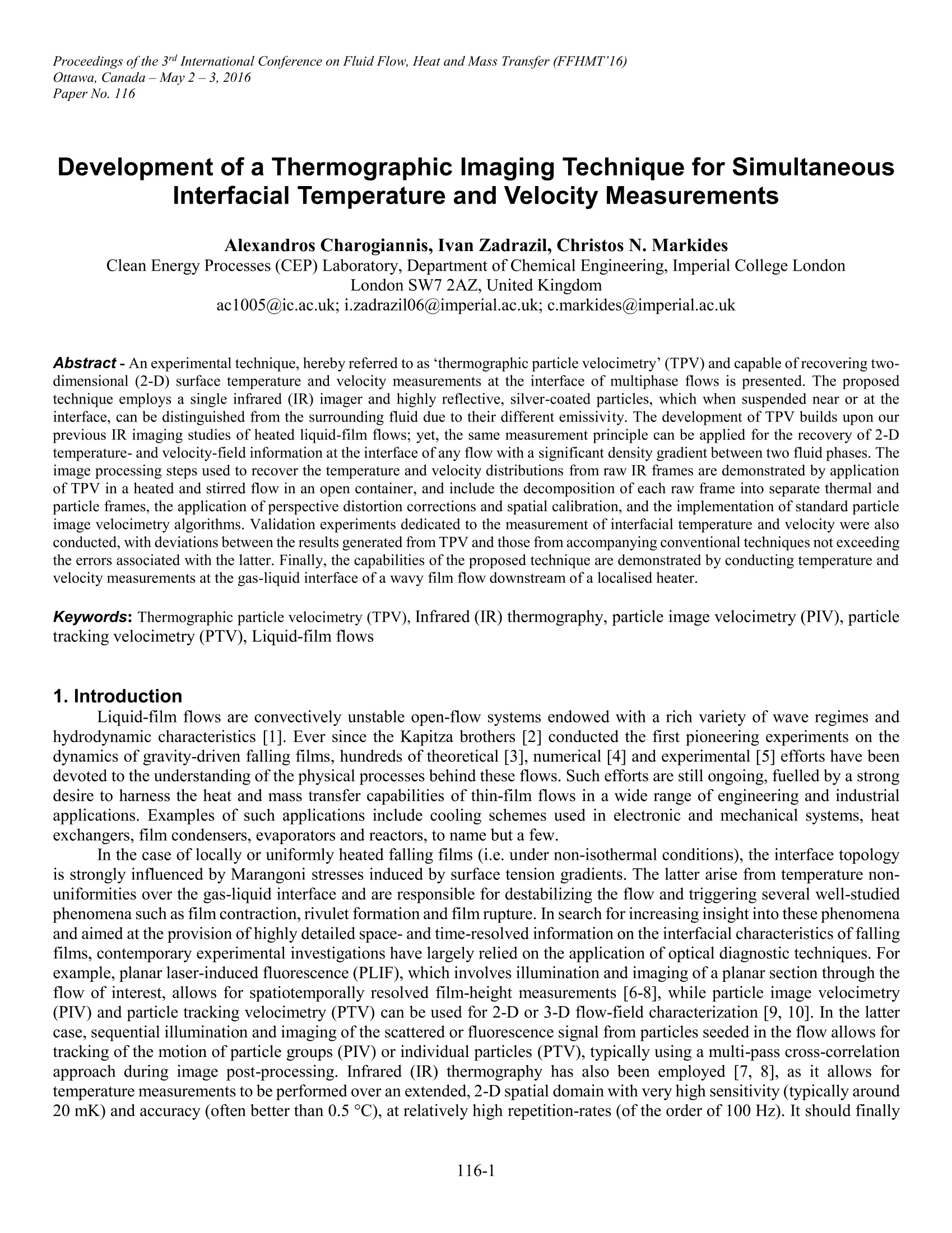


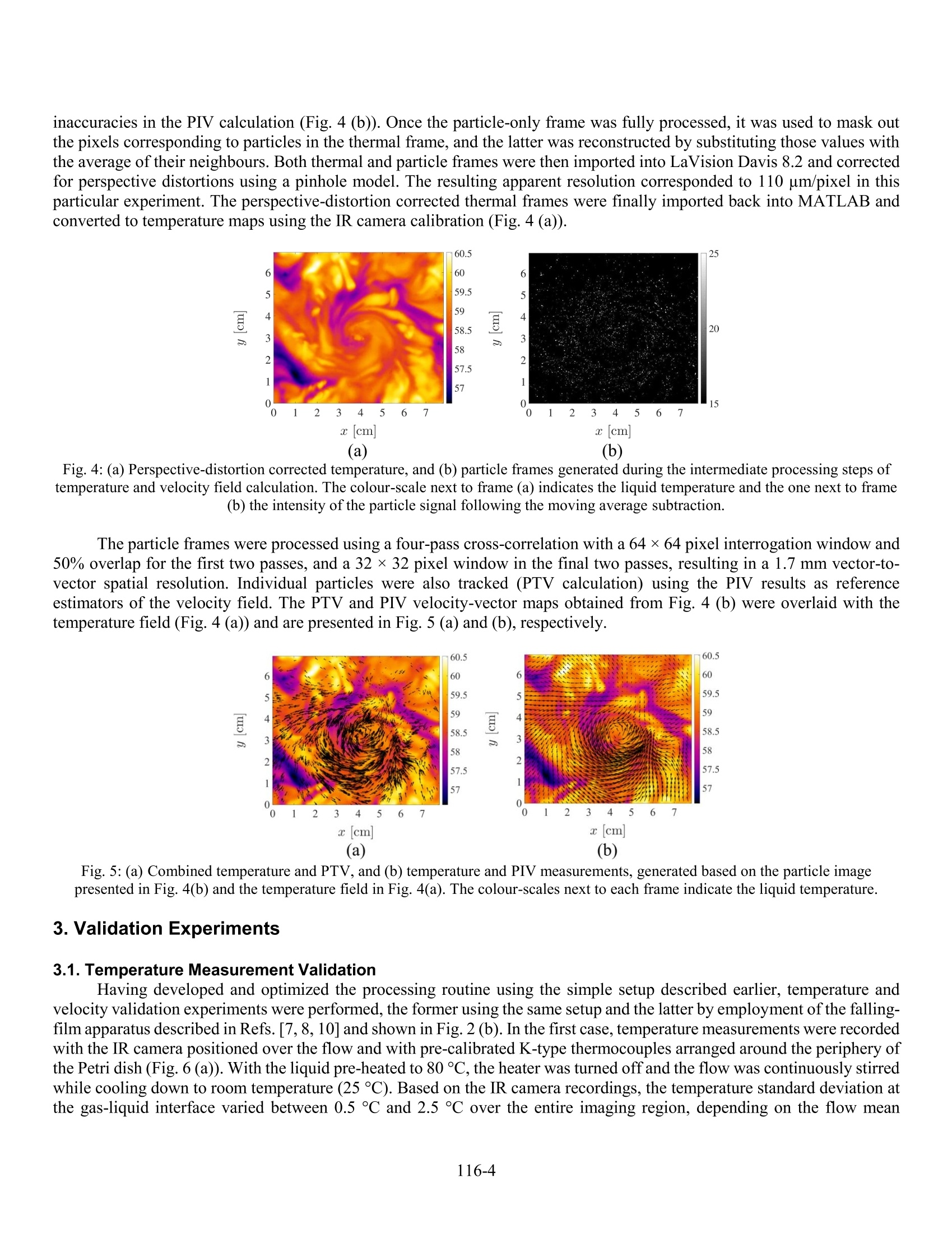
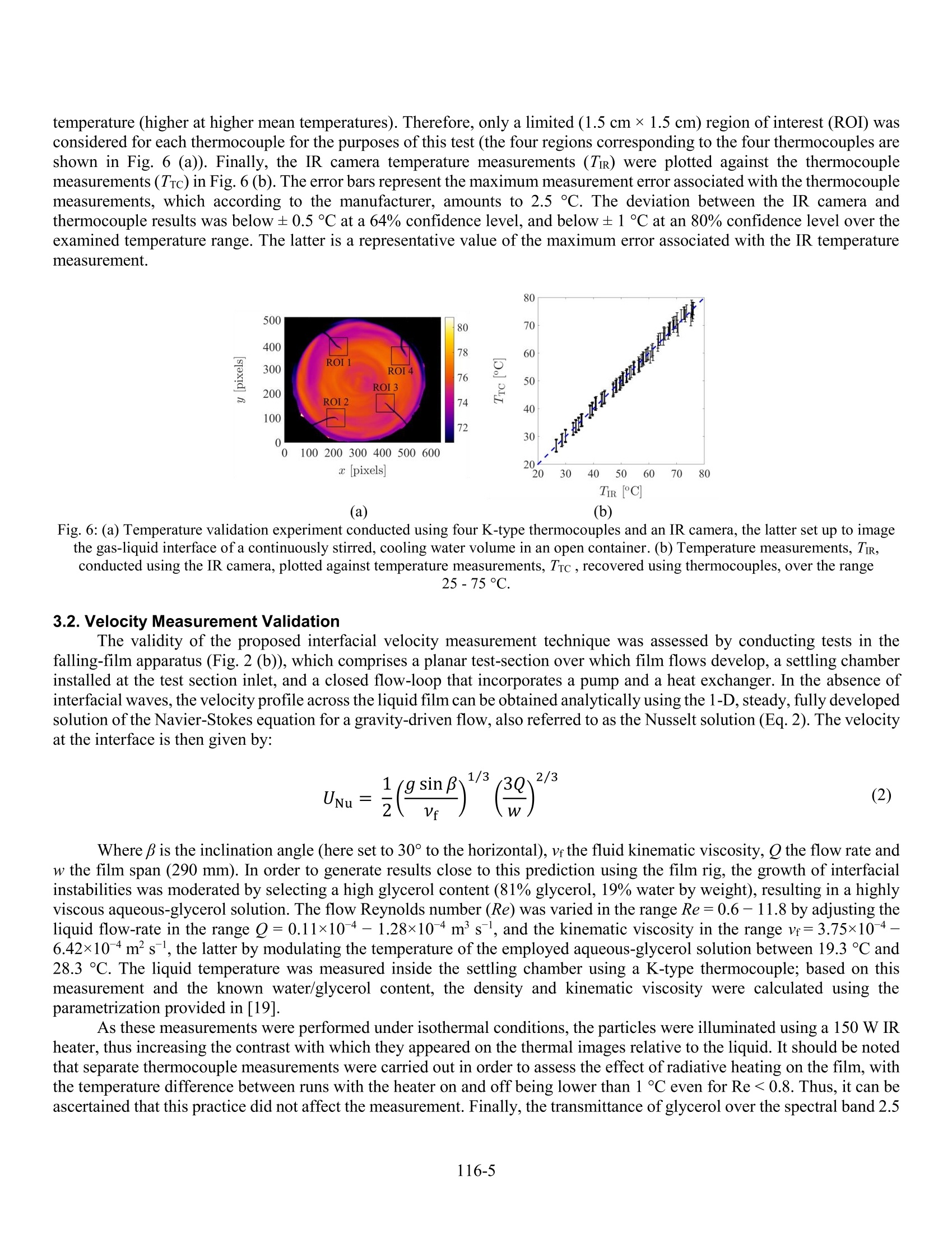
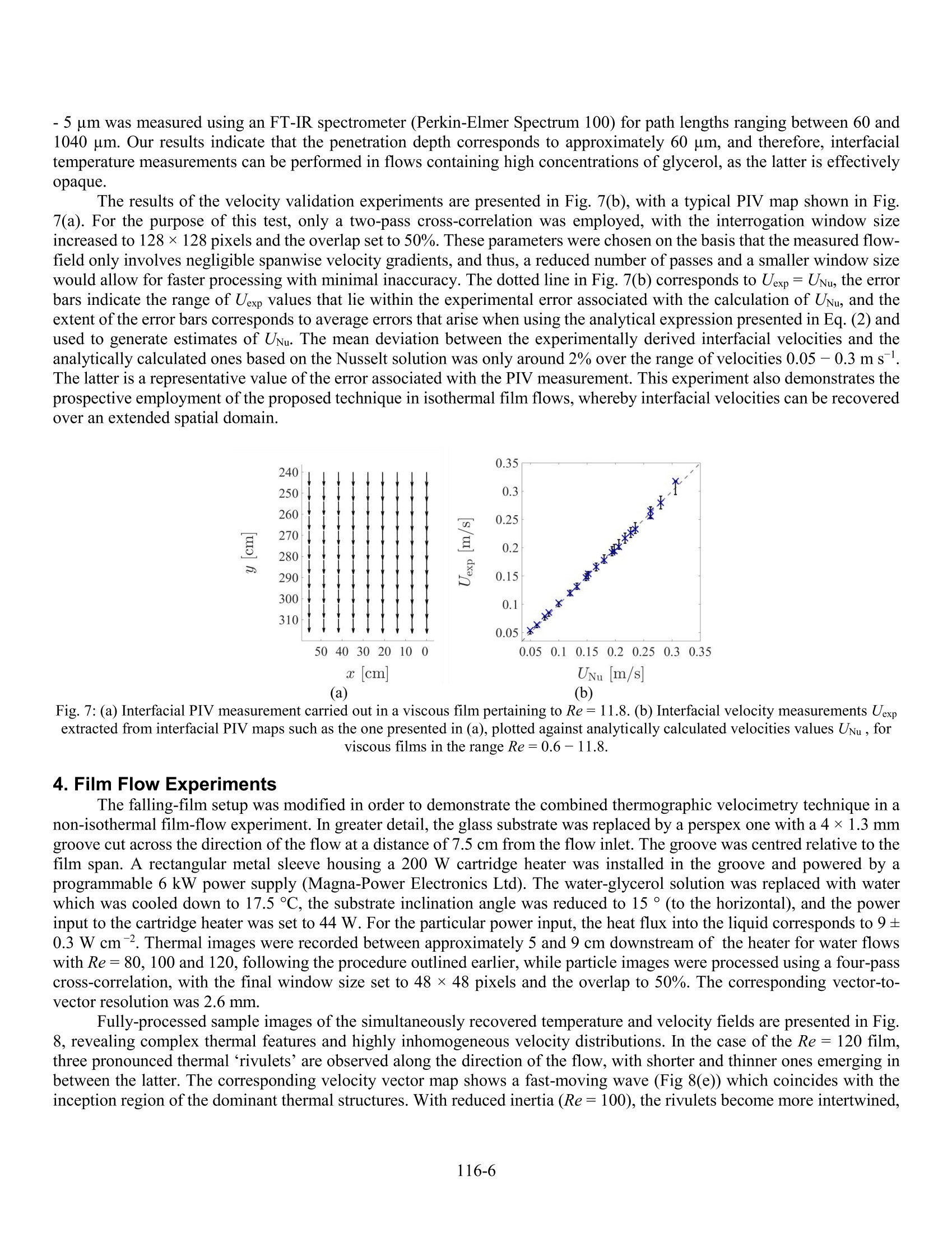
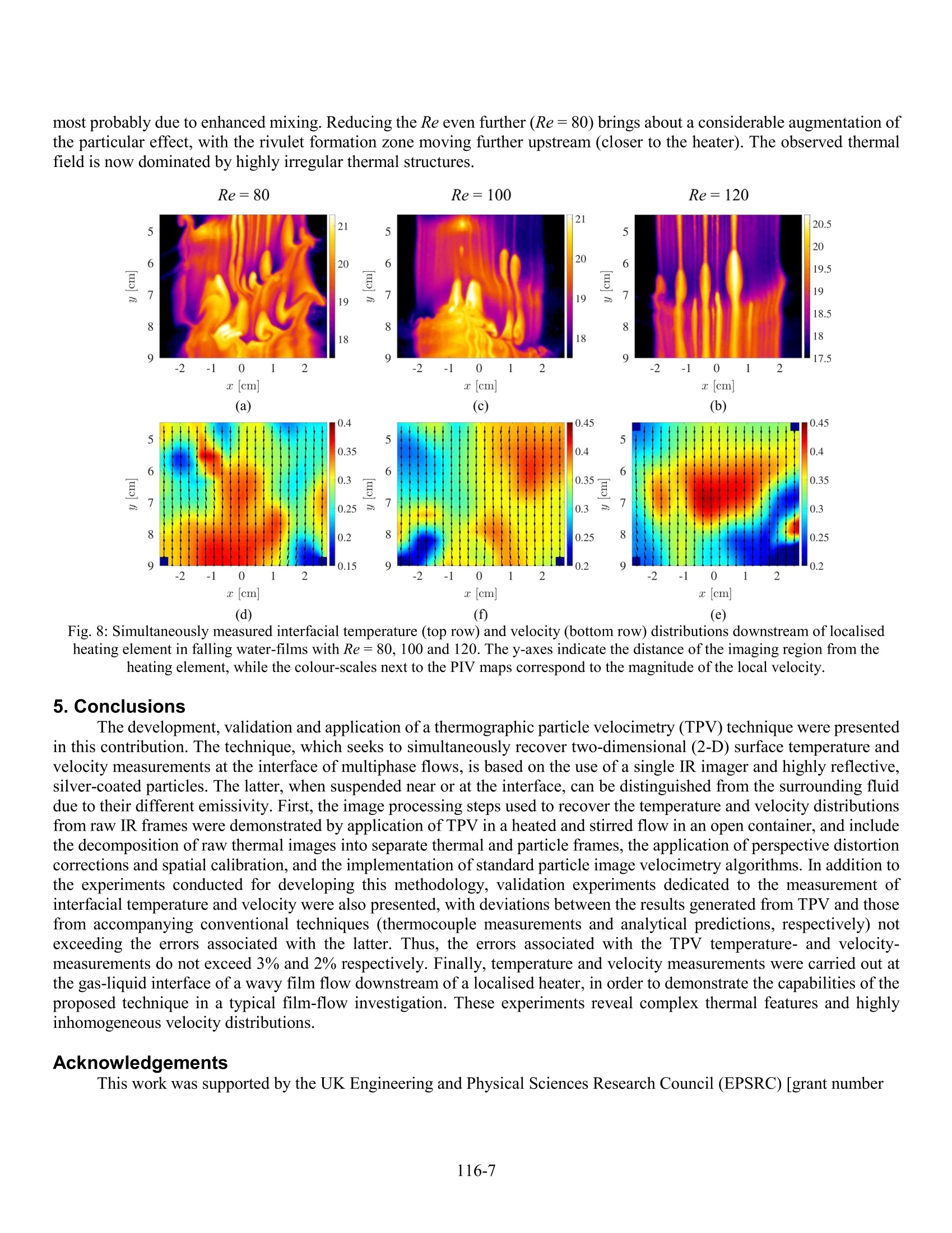
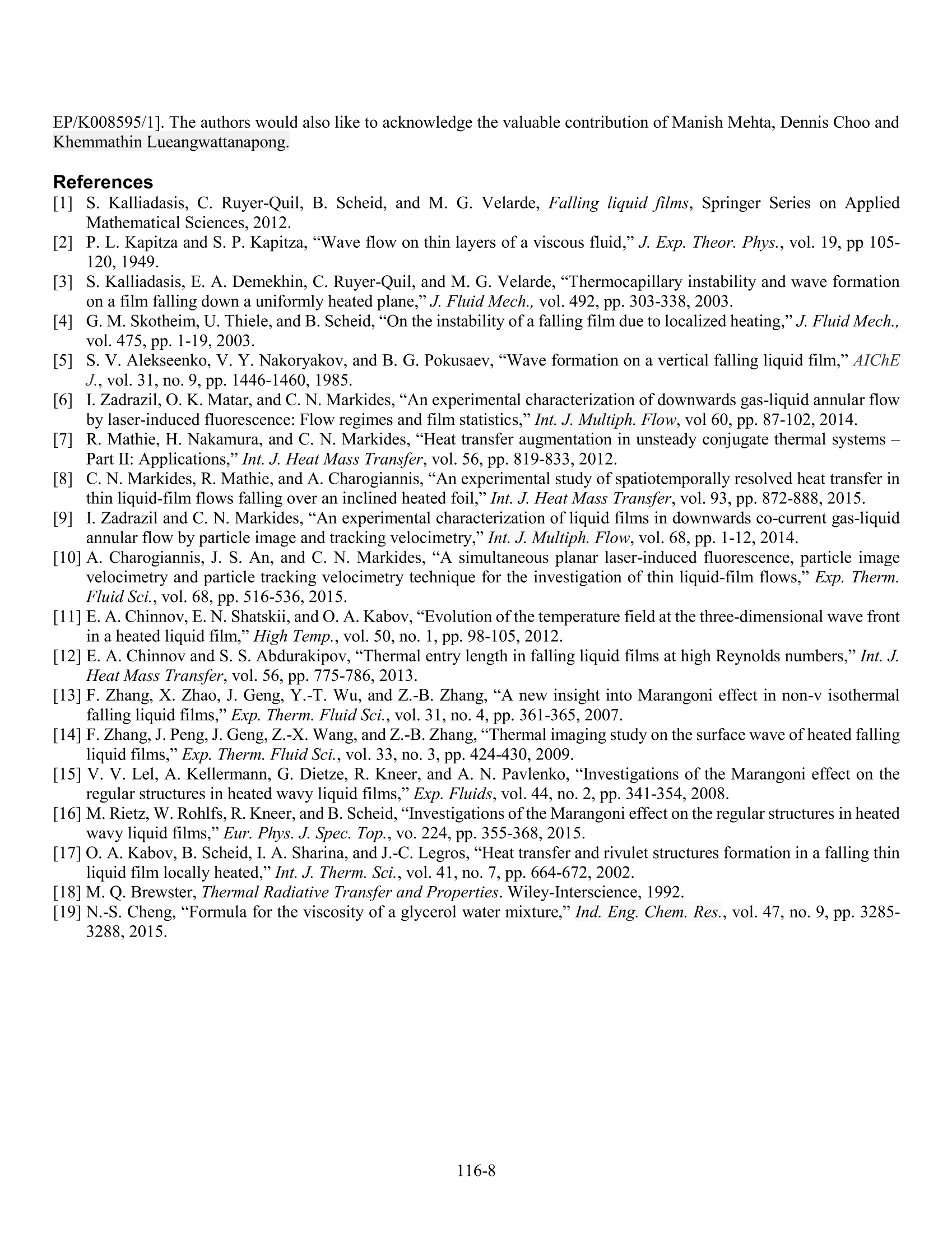
还剩6页未读,是否继续阅读?
北京欧兰科技发展有限公司为您提供《平面流场中速度场和温度场检测方案(CCD相机)》,该方案主要用于其他中速度场和温度场检测,参考标准--,《平面流场中速度场和温度场检测方案(CCD相机)》用到的仪器有LaVision 热成像粒子成像测速系统(PIV)、PLIF平面激光诱导荧光火焰燃烧检测系统
推荐专场
相关方案
更多
该厂商其他方案
更多

